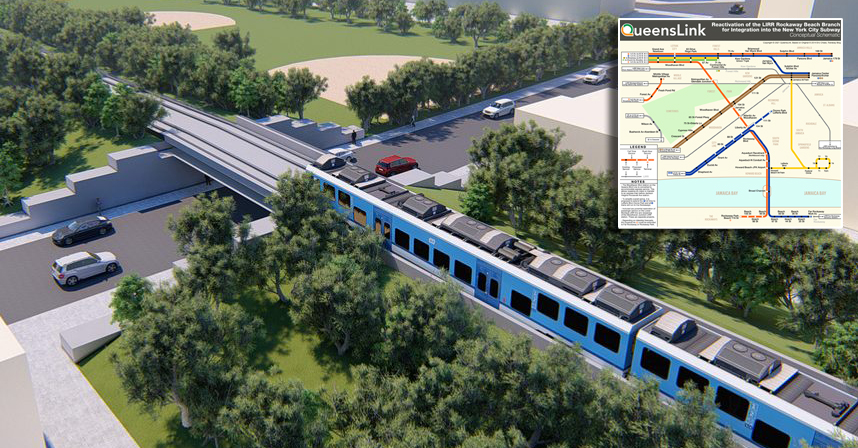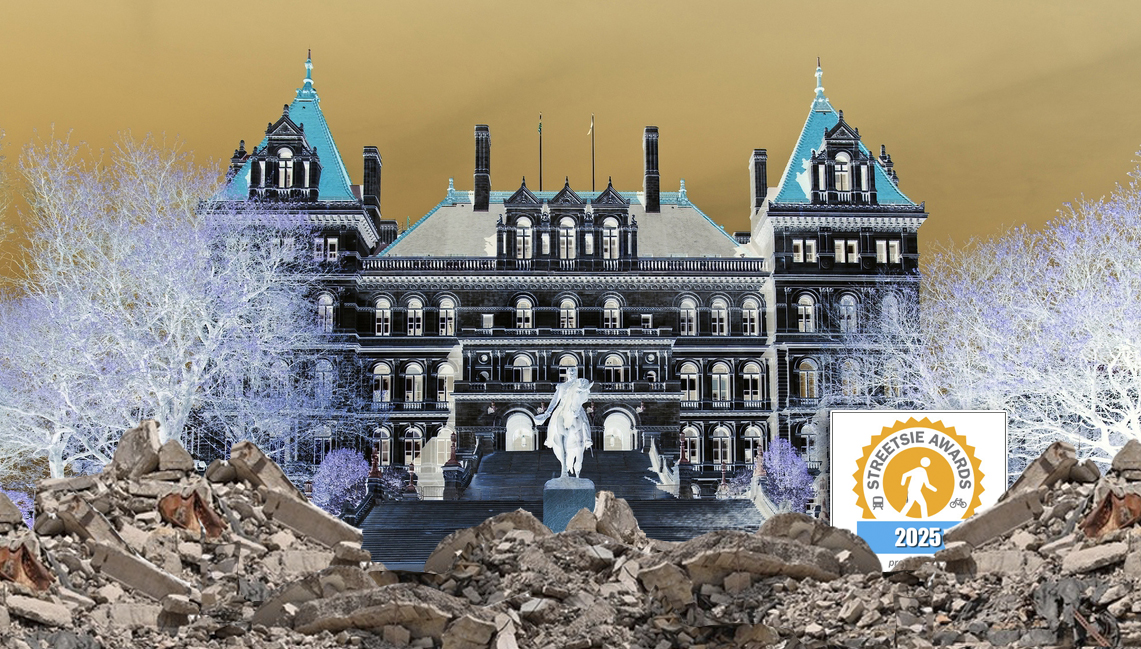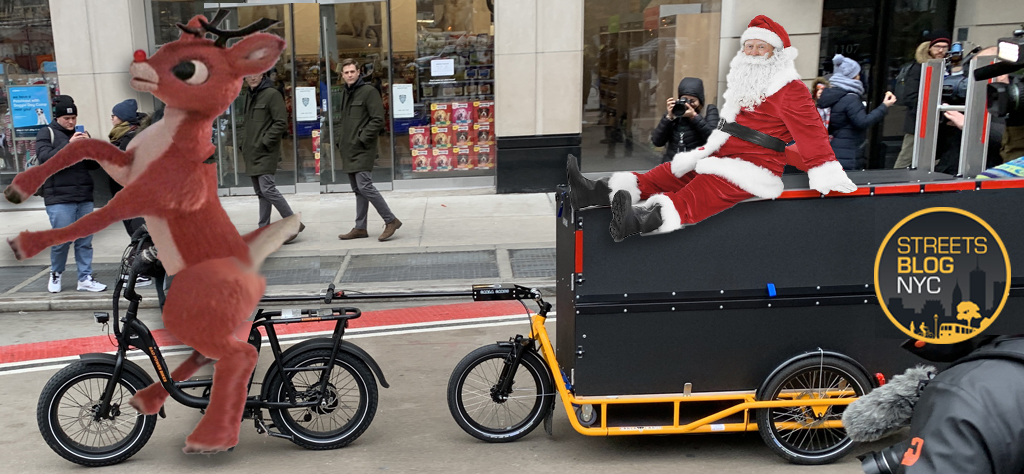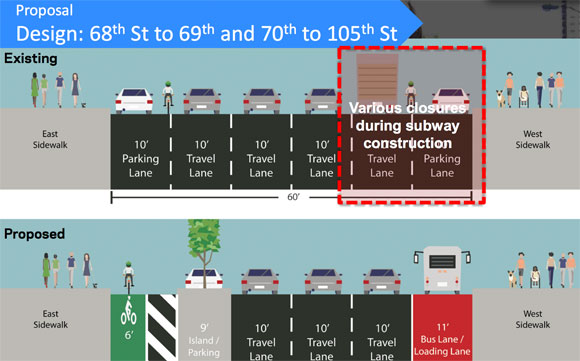
With the conclusion of Second Avenue Subway construction on the horizon, DOT is preparing to move forward with a 2010 plan to add a bus lane and protected bike lane to Second Avenue on the Upper East Side. The project will close a gap in the Second Avenue bus lane and extend the protected bike lane on the avenue from 105th Street to 68th Street. Construction should begin this summer if the MTA meets its schedule for restoring the street.
The plan, which DOT presented to the Manhattan Community Board 8 transportation committee yesterday, promises to create a much safer neighborhood street and nearly 60 blocks of continuous protected bike lane stretching from East Harlem to the UES, but between 68th Street and the Queensboro Bridge, the bike lane will give way to sharrows. For now, DOT has no proposal to extend the Second Avenue protected lane to 34th Street and close a dangerous gap remains in the east side bike network.
After subway construction no longer impedes the surface of Second Avenue, DOT will paint a bus lane for M15 Select Bus Service, filling a gap between 105th Street and 60th Street. Like other M15 bus lanes, these will be enforced from 7 to 10 a.m. and from 2 to 7 p.m. Midday and in the evening, the bus lane will be used for metered parking, and overnight it will be free parking.
The new protected bike lane segment will run from 105th to 68th, though there will be a one-block gap in protection between 69th Street and 70th Street to accommodate a wider sidewalk and new subway entrance. Intersections with one-way streets where car traffic turns across the bike lane will get the "mixing zone" treatment, while at two-way streets, signals will give cyclists and pedestrians a head start on left-turning drivers. At other crossings, pedestrian islands will be installed between the bike lane and car traffic.
From 68th Street to the Queensboro Bridge, a "transitional design" will only add sharrows, providing no protection where traffic becomes most intense. DOT Acting Director of Bicycle and Greenway Programs Ted Wright said at last night's meeting that a protected lane was too much to tackle in this project since congestion on Second Avenue is so severe, but that a future project could extend the protection.
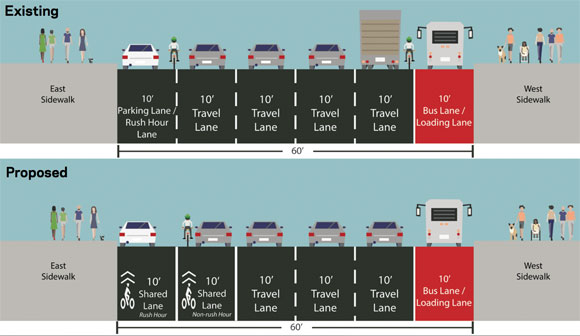
DOT has gradually filled in other gaps in the protected lanes on First Avenue and Second Avenue over the past few years, though none have been as long as the one that remains on Second. In addition to claiming space on blocks with lots of car and truck traffic, fixing the Second Avenue gap will require design solutions for complex intersections with the approaches for the Queensboro Bridge and Queens Midtown Tunnel.
Committee co-chair A. Scott Falk highlighted the conspicuous gap and implored DOT to make the streets by the Queensboro Bridge safer. “I want you to look a creative ideas because we know that there’s not an easy solution at the Queensboro Bridge,” he said.
Falk joined with advocates and committee members in commending the overall plan. “I don’t believe that the right thing to do following construction is to try to restore the highway that used to be there to get people from Harlem downtown,” he said. “I believe that this design makes everyone in this room safer.”
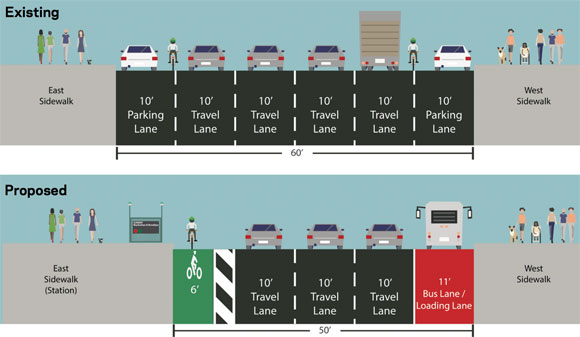
While there was a smattering of comments about “dangerous cycling,” licensing cyclists and bikes, and other standard bikelash fare, the room was generally in favor of the plan. Only a few safe streets advocates were given the chance to speak, but their statements in favor of the proposal received a noisy and positive response from the audience. “There are benefits for cyclists, for motorists and pedestrians,” committee member Sharon Pope said of the plan. “I would ask if we could please separate the behavior [of some cyclists] from the specific and actual benefits of this program because we need it."
CB 8 approved the initial plan in 2010, and DOT intends to move ahead with implementation as soon as the MTA restores Second Avenue, which DOT anticipates to be in the late summer.
Speaking before the meeting, Council Member Ben Kallos was supportive of the proposal. “I am for a complete street proposal that provides a protected bike lane to provide pedestrians, cyclists and motorists a safe way to use the street,” he told Streetsblog.
Hindy S from @NYC_SafeStreets ends her barn burner in favor of Second Ave bike lane to huge applause! @transalt pic.twitter.com/zyPSs7xXCm
— Thomas DeVito (@PedestrianTom) January 7, 2016

